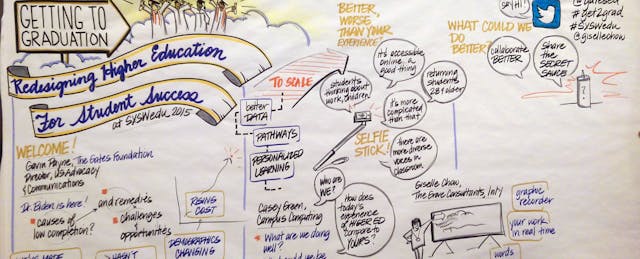“Community colleges do not choose and pick their students; we work with all students to help them become who they aspire to be.”
So shared Dr. Jill Biden, Second Lady of the United States and a community college professor of over 20 years. Her keynote capped off a morning session organized by the Gates Foundation at SXSWedu, “Re-designing Higher Education for Student Success,” which explored the question: How is today’s college experience different than that of decades ago?
Prior to Biden’s speech, the question was first directed to the audience by Casey Green, founding director of the Campus Computing Project. Those who replied seemed to agree that many of today’s students enter with concerns other than schooling experience.
“The students are thinking about a variety of things instead of looking at having an experience in what is a liberal arts education,” said Andrea Stokes, director of the Center for Transformational Learning at Avila University. “They’re thinking about work, children and having to pay the bills….This doesn’t mean they’re not loving the residential experience, [but] there are just less of them out there.”
Valerie Inniss Bertrand, a student at University of Massachusetts-Amherst, underscored the financial concerns that burden her peers. She described the “lack of financial aid literacy and the lack of financial aid itself” as one of the biggest challenges for higher-ed students. She asked: “How can we create a secure safety net that will accommodate the needs of different students?”
The new student demographic was acknowledged by the Second Lady. “In reality, this is the new student: they are often older, juggling work, school and families,” says Biden. These competing responsibilities can make finishing school difficult. Of an estimated 9 million students who attend a community college in the US, less than half graduate or transfer to a 4-year institution within six years, says Biden.
Biden reiterated some of the work that the current administration has led to make higher education “accessible, affordable and attainable for all Americans,” including raising Pell Grant dollars, a $2 billion workforce plan to “strengthen partnerships between schools and employers,” and Obama’s plan to make community college free.
She also referenced Obama’s “Student Aid Bill of Rights,” signed Tuesday morning as an effort to help the 70 percent of undergraduates who finish school with debt, which on average is more than $28,000. The Presidential Memorandum calls for companies that provide student loans to be more transparent about providing information about repayment procedures and help borrowers make their monthly payments. Otherwise, these companies may find themselves listed on a “state-of-the-art complaint system” website that the Department of Education will create.
The White House also released a fact sheet that provides estimated totals of borrowers and their total outstanding loans for each state. (California tops the list with over four million borrowers and more than $112 trillion in loans.)
Biden acknowledged the role of technology in increasing access to quality education and student retention. After visiting Santa Fe Community College in Gainesville, Florida and Austin Community College in Texas, she praised them as “two schools [that] are meeting students where they are, and guiding them to where they want to go, through the use of new technological advances.”
Increasing access to higher education is the first step; the next challenge is to make sure those who take advantage of the opportunity finish on time. “We’ve made great strides in access but that hasn’t translated to completion for all,” says Gavin Payne, director of US Program Advocacy and Communications, earlier during the session.
“We all know the responsibility for educating students is not the student itself. It is a responsibility that belongs to all of us. We must adapt to meet students’ needs in order to graduate more students,” Biden declared.
Biden has lived up to her words: a week after Obama and Biden were elected to the White House in 2008, she returned to the classroom. “Teaching is not what I do--it is who I am.”


